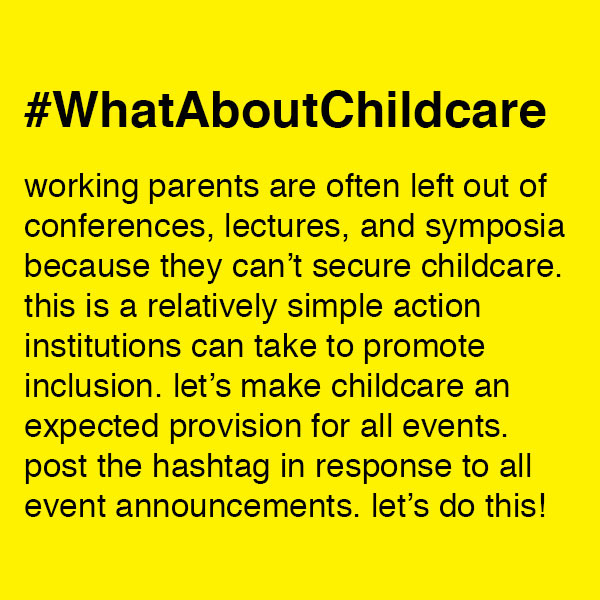Raising a Family in the Academy
We write from embodied experience. Giving birth and raising children on the tenure-track. Taking care of those at the end of life, whether young or old. Living in queer family formations and taking care of those whose families do not accept them. Doing all of these things at once. We preface these lived experiences because we are committed to embodied thinking; it alters how we experience our work as designers, researchers, and educators. Through buildings, practice, scholarship, and pedagogy—architecture is better understood with intimate knowledge about the different bodies it houses as they are born, grow old, and die.
Figure 1. The Solidarity Bloc is an informal, non-institutional space to offer community support and discussion on the #metoo movement in architecture, n.d.. Credit: The Architecture Lobby.
We are members of The Architecture Lobby, a decentralized, growing organization with chapters in cities across the United States. The labor-organizing activities of The Architecture Lobby in professional practice, already underway, pushes us to think about labor relations in the university. Here, in this post, we aim to lay out the ways in which care-giving, and particularly raising a family, misaligns with the labor expected of us as academics in architecture schools. We know that families come in many shapes and forms and that it is rare to find an academic without caregiving responsibilities, and yet, the relation between the two conditions is seldom raised in architecture schools. We take a deliberate risk in this post—we intend to provoke change by addressing the subject of family and advocating for action regarding the problems posed by carework in the academy (Figure 1)[1].
Studio Patriarchy
The consequences of committing oneself to caring are uneven. Care work is undervalued in architecture schools, a disregard that is reinforced and complicated through attitudes toward gender and assumptions about motherhood in a capitalist political economy. Domestic labor is naturalized and seen as inappropriate to reference in the public sphere; the noise and mess of childhood are quite far from the silence and sterility of the lectern: the joy of children isn’t welcome in the design review. Architecture students may learn about the radical arrangements chronicled by Dolores Hayden in The Grand Domestic Revolution but architecture schools do not take heed of the experiments, where nearby kitchens and crèches reduce the physical separation of laborers from their families[2]. Instead, the role of the female parent continues to be idealized, cast as domestic goddess, and mothers who can afford to place their children in the care of others are judged as inferior. Doubly, deciding to take care of our families ourselves is perceived as evidence of not being invested in academic work. Carework is expensive, whether given in a daycare center or at home; the challenge of being able to afford to hire a caregiver, isn’t addressed. As fellow Lobby member Myra Lara reminded us as we were writing this post, patriarchy works through processes of devaluation and alienation; it splits families and creates silences. We hope that this essay will foster a more open discussion of parenting while teaching architecture[3].
Figure 2. A manifesto poster from union organizing efforts, n.d. Alternatively, who can teach in the architectural academy? Credit: Workers' Inquiry: Architecture.
Working in an architecture school exaggerates these challenges because of a destructive work culture and enduring sexism[4]. The esteem for solo heroism endemic to the profession extends into learning environments, with an emphasis on long meeting times for design studios. Studio is an enviable, holistic model of teaching as it foregrounds human contact for education. But it is dominated by a culture of overwork. The often-heard counsel is that students needed to be “toughened” in school to withstand the challenges of practice. Architecture schools, instead, should be places where experiments in all aspects of design practice are encouraged, including alternative life-giving models. We need to reconsider the value of time and put to better use these hours of dialogue and explanation. And we need to discourage ridiculous feats of physical endurance, such as the expected all-nighters, that have long been celebrated in design studio education. Such changes will help students as well as faculty better balance studio work with self and family care (Figure 2).
“Architecture is better understood with intimate knowledge about the different bodies it houses as they are born, grow old, and die.”
Everyday Childcare
Raising a family and caring for loved ones is a round-the-clock responsibility, often requiring paid or unpaid assistance. The scheduling of studio courses poses a special challenge to caregivers who wish to attend extracurricular events, which often follow studio, in the evening. Parents who attend evening lectures are unlikely to see their children for dinner or even bedtime that night (Figure 3). Families, already pressed, stretch resources to cover expenses beyond what they have already allocated to pay for daytime care. Money is tight. Many junior faculty carry their own student loan debts. There is also a gendering to who leaves and who stays. A man leaving to take care of his children makes him seem like a feminist, while a woman leaving to do the same work further entrenches heterosexual, gendered models. “Leaving already?” is a comment that a woman can expect to hear from a male colleague when she leaves an architecture school at five o’clock. Her arrival at eight o’clock in the morning, his arrival at two o’clock in the afternoon, isn’t part of the exchange. In response, some architecture schools schedule events at lunch time in addition to the evening. Yet inequalities still hold; colleagues earn social capital at the dinners where guests are entertained after evening lectures, not at luncheons.
Figure 3. #WhatAboutChildcare is a crowd-sourced project calling for childcare at architecture events, n.d.. Credit: Feminist Wall.
As a remedy we need to collectivize the everyday work of social reproduction[5]. A progressive approach to childcare in academic life would destigmatize the presence of children within our schools, and get our universities to offer flexible-hours childcare and pay for it[6]. Raising a family in the academy requires childcare outside of the hours that primary schools, preschools, and daycares are open—or that paid caregivers are willing to work. As our fellow Lobby member Sharone Tomer suggested in discussions of the topic, why not welcome children on occasion into our classrooms? If we strive to teach our students to imagine a profession open to embodied differences, let's teach them to learn from children how to understand the built environment.
Family Planning
Raising a family requires a lot of planning while also having its own rhythms and being somewhat impossible to plan for. Much as we may deconstruct gender, women's fertile years coincide with the years of doctoral education and tenure-track appointments. These are crucial career years, and the conflict is acknowledged in the U.S. usually with a semester of parental leave for every new child. Yet a single one-year delay on the tenure clock is offered, no matter the number of children. And many faculty aren’t permitted to take more than one leave. Two kids? Forget it. Or not. So take an unpaid leave. Or take a short one. Masses of adjunct faculty get even less assistance. Some universities offer teaching relief or modified duties, but others fall back on the minimum support granted by local governments, if it exists at all.
Figure 4. We seek to organize in our places of work, doing so in solidarity with those less privileged. Credit: Guerrilla Girls, What I Want For Mother’s Day, 1991. Copyright © Guerrilla Girls, courtesy guerrillagirls.com.
Put simply, having children and taking leave works against an academic career. To make matters worse, no matter the policy, men can and often do use the leave to work, while women face postpartum challenges and a new baby to care for. Moreover, academic parents who use their benefits are made, at least implicitly, to feel as though they owe something. That raising a child is a privilege. That raising a child is a strange hobby. That it is unnatural to perform care work oneself. That one lacks academic dedication. That one has placed financial or logistical burdens on the department. This further complicates caring for children or for extended families. Leave policies should be normalized, and not conceived as minimum support structures (Figure 4).
Conclusion
Raising families and providing care for other loved ones makes us better teachers who have a richer view of the many kinds of human beings that architecture should be designed for. It forces us to consider the many kinds of needs and abilities, and we bring these lessons to our teaching and scholarship. We empathize with students, and we are invested in teaching the next generation at work—and at home. We do not have time for the kind of petty intrigue—gossip and turf wars—that too often consumes our architecture schools. Rather, we seek effective community at work and at home. We teach nonviolence to our children; we teach our children to be ethical. Two wrongs don’t make a right; we explain justice, equity, and inclusion as we teach children to share, label their emotions, and understand the feelings and needs of others. This hidden “second shift,” as Arlie Russell Hochschild terms it, is spent rocking babies, sitting next to a hospital bed, running errands for those who cannot[7]. This is time to value others. It draws us close. It makes us hungry for better ways to live.
Centering care work in the academy calls for alternative formations of our universities. Ones that recognize the value and importance that social reproduction and the ethics of care bring to academic life. In challenging the status quo, we take inspiration from the feminist economic geographers J. K. Gibson-Graham, who have adopted a shared name in keeping with their movement to establish “community economies.”[8] How do we frame our architecture schools as communal enterprises? As founding member of The Architecture Lobby, Peggy Deamer commented on a draft of this essay, “the stake of the university should be in the whole person, not just the knowledge producer.” Let's change the stakes. There is an academic caucus forming in The Architecture Lobby. And we aim to take action: Consider joining us. We will notify you about the next call-in later this summer.
Citation
Joy Knoblauch, Sben Korsh, Brent Sturlaugson & Olivier Vallerand, “Raising a Family in the Academy,” Platform, July 18, 2019.
Notes
[1] We are grateful to our Lobby’ers, Peggy Deamer, Marta Catalan, Valentina Rozas-Krause, Priyanka Shah, Sharone Tomer, Myra Lara, and Naraelle Hohensee, for their comments on earlier drafts of this text.
[2] Dolores Hayden, The Grand Domestic Revolution: A History of Feminist Designs for American Homes, Neighborhoods, and Cities (Cambridge, Mass.: MIT Press, 2000).
[3] Emily Oster, "End the Plague of Secret Parenting," The Atlantic, May 21, 2019.
[4] For a list of all male or majority male high-profile juries and architecture events, as well as advocacy for the hashtag #whataboutchildcare, see Feminist Wall.
[5] As feminist political philosopher Nancy Fraser argues, “socialism cannot simply mean socialized ownership of the means of production, it also [has] to mean the collectivization of house work and social reproduction.” See also, Silvia Federici, Revolution at Point Zero: Housework, Reproduction, and Feminist Struggle (Brooklyn, N.Y., and Oakland, Calif.: PM Press, 2012).
[6] See Joan Tronto, “Creating Caring Institutions: Politics, Plurality, and Purpose,” Ethics and Social Welfare 4, no. 2 (July 2010): 158-71.
[7] Arlie Hochschild with Anne Machung, The Second Shift (New York: Avon Books, 1990).
[8] The Community Economy Institute offers a variety of resources for those looking to organize their local economies around principles of community. For a theoretical critique of classical Marxist theory, and the ways in which it hinders our ability to make change for our families, see J. K. Gibson-Graham, The End of Capitalism (As We Knew It): A Feminist Critique of Political Economy (Minneapolis: University of Minnesota Press, 2006).







